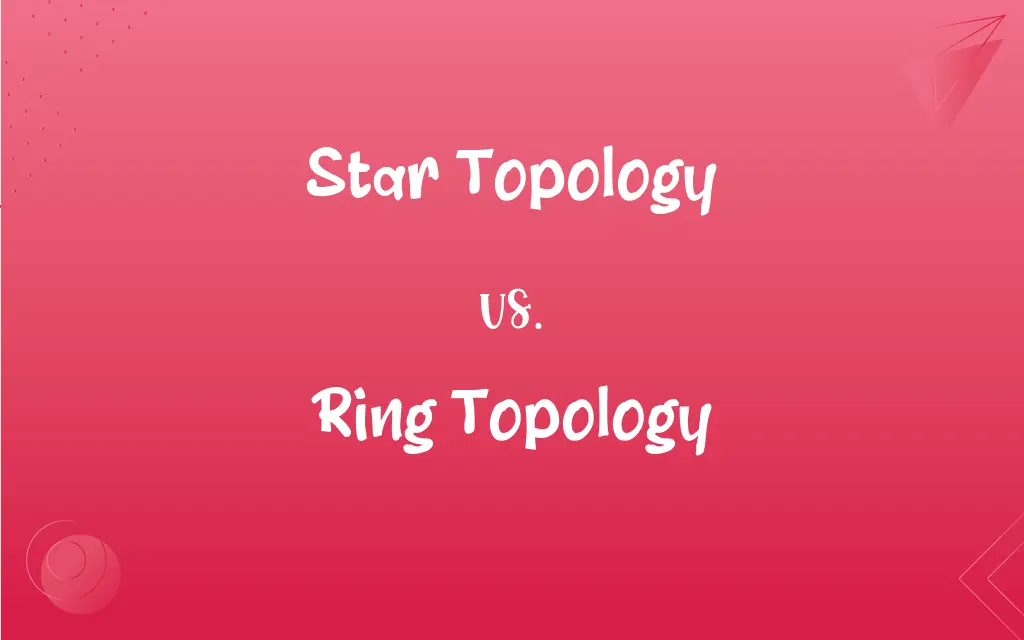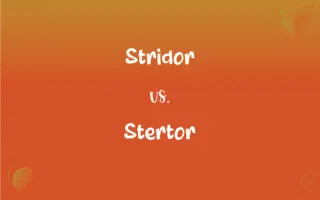Star Topology vs. Ring Topology: What's the Difference?
Edited by Aimie Carlson || By Janet White || Published on March 28, 2024
Star topology involves devices connected to a central hub, whereas ring topology connects devices in a circular sequence with no central hub.

Key Differences
Star topology is a network configuration where each device is connected to a central hub or switch. In contrast, ring topology connects each device to exactly two other devices, forming a single continuous pathway for signals through each device, akin to a ring.
In star topology, the central hub acts as a repeater for data flow. This centralization allows for efficient management and problem isolation. On the other hand, ring topology creates a closed loop, where data travels around the ring in one direction, either clockwise or counterclockwise.
A significant advantage of star topology is its robustness; if one link fails, it doesn't affect the rest of the network. However, ring topology is sensitive to failures as breaking the loop (ring) can halt the entire network.
Star topology simplifies adding or removing devices as it only requires connecting or disconnecting from the central hub. In contrast, modifying the ring topology can be more complex since it involves reconfiguring the loop.
In terms of performance, star topology can handle heavy traffic more effectively due to the central hub managing data transmission. Ring topology, however, might face delays as data must pass through multiple nodes before reaching its destination.
ADVERTISEMENT
Comparison Chart
Structure
Central hub connected to all devices
Devices connected in a closed loop
Failure Impact
Individual link failure doesn't affect others
Failure in one link affects the entire network
Expansion
Easier to add/remove devices
More complex due to loop configuration
Data Flow Management
Managed by the central hub
Data flows in a single direction around the ring
Performance
Better at handling heavy traffic
Can face delays due to multiple node traversal
ADVERTISEMENT
Star Topology and Ring Topology Definitions
Star Topology
Star topology features a single point of failure at the hub.
In our star topology setup, the router's malfunction disrupted the entire network.
Ring Topology
In ring topology, data travels in one direction around the loop.
The ring topology in our office network ensures data flows in a clockwise direction.
Star Topology
Star topology allows easy addition and removal of devices.
Adding a new printer to our star topology network was a simple task.
Ring Topology
Modifying the ring topology requires reconfiguration of the loop.
Adding a new server to our ring topology required careful planning to maintain the loop.
Star Topology
A network configuration with each device connected to a central hub.
The office's network, built in a star topology, remained functional despite one computer disconnecting.
Ring Topology
Ring topology often faces delays due to data passing through multiple nodes.
Data transfer in our ring topology network is slower because it has to go through several nodes.
Star Topology
It centralizes data traffic management in the network.
Our network's star topology enables efficient management of data traffic through the central switch.
Ring Topology
Ring topology can be disrupted by a single point of failure.
When one workstation went offline, the entire ring topology network was affected.
Star Topology
Star topology is characterized by its simplicity and ease of troubleshooting.
Troubleshooting our network issues was easier due to the star topology’s clear structure.
Ring Topology
Ring topology connects each network device to two others, forming a closed loop.
The school’s computer lab uses a ring topology, ensuring each computer is connected in a loop.
FAQs
What defines ring topology?
Ring topology connects network devices in a circular sequence, forming a loop.
What is star topology?
It's a network setup where each device is connected to a central hub.
Can star topology easily accommodate new devices?
Yes, adding or removing devices is straightforward in star topology.
How does star topology handle device failures?
In star topology, a single device failure doesn't impact the rest of the network.
Which topology is better for heavy traffic management?
Star topology is more efficient in handling heavy traffic.
How complex is it to add a device in ring topology?
It's more complex due to the need to maintain the continuous loop.
How is troubleshooting in star topology?
Troubleshooting is easier due to the centralized structure.
Is ring topology resilient to failures?
No, a single failure can disrupt the entire network in ring topology.
What is the major drawback of star topology?
Its major drawback is the single point of failure at the central hub.
Is star topology good for small networks?
Yes, it's particularly effective for small to medium-sized networks.
What type of cable is used in ring topology?
It typically uses twisted pair or fiber optic cables.
Do modifications in ring topology impact the whole network?
Yes, modifications can require reconfiguration of the entire loop.
Can star topology use different types of cables?
Yes, it can use twisted pair, coaxial, or fiber optic cables.
How does data flow in ring topology?
Data travels in one direction around the loop in ring topology.
What happens in ring topology if data transmission is disrupted?
Disruption in one part can halt data transmission throughout the network.
Are star networks cost-effective?
They can be, but the cost depends on the hub’s capabilities and scale.
How does ring topology affect network speed?
Network speed can be slower due to data passing through multiple nodes.
Is data collision a concern in ring topology?
Less so, as the ring structure directs data flow in a single direction.
Is ring topology suitable for large networks?
It's less suitable for very large networks due to delay and complexity.
Can star topology scale well?
Yes, it scales well with the right central hub equipment.
About Author
Written by
Janet WhiteJanet White has been an esteemed writer and blogger for Difference Wiki. Holding a Master's degree in Science and Medical Journalism from the prestigious Boston University, she has consistently demonstrated her expertise and passion for her field. When she's not immersed in her work, Janet relishes her time exercising, delving into a good book, and cherishing moments with friends and family.
Edited by
Aimie CarlsonAimie Carlson, holding a master's degree in English literature, is a fervent English language enthusiast. She lends her writing talents to Difference Wiki, a prominent website that specializes in comparisons, offering readers insightful analyses that both captivate and inform.
































































